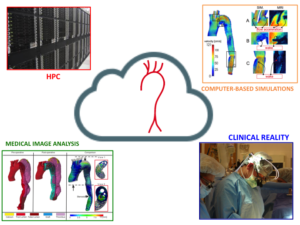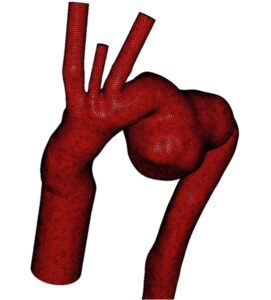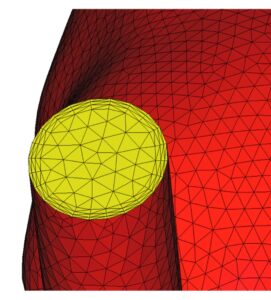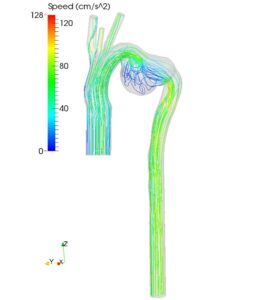iCardioCloud. Bringing cardiovascular virtual reality to clinical bedside practice through cloud platform: implementation of a US excellence paradigm into Lombardia SSR
Rationale. iCardioCloud starts from the following three main arguments:
- Cardiovascular disease (CVD) is a social and an economical emergency; each year, CVD costs 503.2 billion dollars in United States (US) and 196 billion euro in Europe (EU).
- An important contribution to the development of novel diagnostic/therapeutic tools and options is represented by in silico analysis, relying on computer-based simulations.
- Unfortunately, the implementation of in silico analysis into the clinical practice requires a significant integration of knowledge and an elevated high-tech know-how, which is already available in Lombardia but not yet fully addressed.
 Goals. Consequently, the iCardioCloud project plans to create a strong regional consortium and an internationally recognized training path, to improve the Lombardia health-care system, deeply integrating the clinical practice and in silico analysis for (endo)vascular surgery. Consequently, the project plans to move toward an optimization of cardiovascular procedures, having a final positive impact on increment of procedure effectiveness and a reduction in terms of overall procedural costs.
Goals. Consequently, the iCardioCloud project plans to create a strong regional consortium and an internationally recognized training path, to improve the Lombardia health-care system, deeply integrating the clinical practice and in silico analysis for (endo)vascular surgery. Consequently, the project plans to move toward an optimization of cardiovascular procedures, having a final positive impact on increment of procedure effectiveness and a reduction in terms of overall procedural costs.
Expected results and Benefits for Lombardy. The project success will boost Lombardia health-care system through the implementation of the collaborative paradigm between physicians and engineers, already on-going in specific excellence centers of US health-care System (for this purpose, iCardioCloud project has recruited Prof. A. Veneziani, professor at Emory University).
Project Partners:
Large-scale CFD patient-specific simulations.
It is well known that hemodynamics is of clinical relevance. We aim at solving real hemodynamics problems with medical impact using Computational Fluid Dynamics. The main issues are four folds:
- Acquisition and reliability of the data
- Complex 3D meshing strategies
- Accuracy and stability of the numerical methods
- Powerful and efficient CFD softwares
- Analysis and evaluation of the obtained results
The first problem involves medical imagineering techniques as well as in order to recover the geometry of the problem. In particular, robust methods, such as CT scan, are used. Mathematical modeling requires a geometry and thus efficient 3D mesh softwares are necessary. Also inflow and outflow boundary conditions are obtained using cutting edge MRI techniques.
The problem is complex, full 3D incompressible Navier-Stokes equations; reduction order for boundary inflow/outflow conditions (in order to take into account a much more complete representation of the human circulatory system) requires advanced techniques and tools. In particular are used: state-of-art preconditioning, Windkessel lumped models, etc.
The numbers of equations involved are in millions, and some cardiac cycles with a small time step are required in order to achieve a correct accuracy. Therefore parallelized and well-scaled CFD solvers are required, as well as powerful clusters. The software used is LifeV (www.lifev.org), which results from a conjoint work between University of Milano, EPFL, INRIA, and Emory University. Computational resources employed are an in house cluster (Nume-Lab) and also IBM BlueGene/Q systems (CINECA/FERMI, ranked 12 in June 2013 in the top500).
The partnership is composed of doctors, engineers and mathematicians. It permits to deliver a reliable analysis for such a complex problem that is patient specific computational hemodynamics.
Results.
iCardioDays: Closing Workshop Program
NEWS – iCardioDays: Closing Workshop
December 13th, 2016 @ IRCCS Policlinico San Donato (Flyer)
December 14th, 2016 @ Palazzo Vistarino, Pavia (Flyer)




